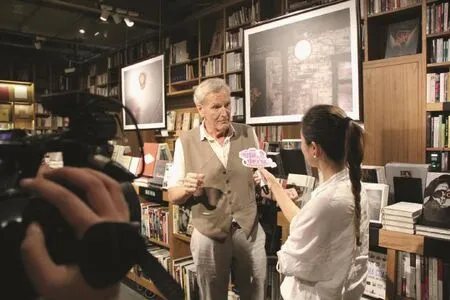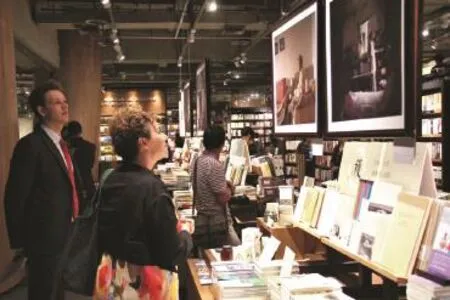光影大师罗伯特在山城摁下的快门
□ 文/本刊记者 李静 摄影/吴岸
光影大师罗伯特在山城摁下的快门
□ 文/本刊记者 李静 摄影/吴岸
之所以乐意为罗伯特·凡德·休斯特的《中国人家》写序,就是因为我在他的摄影作品里看到了从内心出发,抵达表情的尊严。罗伯特·凡德·休斯特精心设计了他需要的画面,然后摁下了快门。我感到,他在摁下快门的时候,心里充满了对被拍摄者的尊重,无论是人物,还是景物,罗伯特·凡德·休斯特都以感激之情对待。
——余华(著名作家)
“老城是一部厚重的历史教科书,一座城市最能唤起人们记忆的通常是它那历史悠久,具有地域特色的老街区、老建筑,重庆老城也不例外。罗伯特先生将他的镜头紧紧逼近普通人家,一些司空见惯的日常生活细节和居住环境被罗伯特用光影、色调和构图表现得生动感人。拍摄场景大都显得朴质简陋,甚至还有些破旧凌乱,但拍摄对象的率真、质朴,情感流露、精神追求以及对美好生活的向往跃然画面,让人记之于心而难以忘怀。”
——何智亚(城市规划建筑专家、历史文化学者、资深摄影家)

已经深深爱上重庆的罗伯特先生接受重庆电视栏目的现场专访

外国友人正仔细欣赏《重庆人家》的摄影作品
“这个角度不错,光线夹杂着灰尘,很有时光流逝感。”6月,初夏的重庆,一位满头银发的外国老人手持相机在位于江北的重庆白猫日化厂旧址兜兜转转,进行摄影创作。
老人来自荷兰,名叫罗伯特·凡德·休斯特,是在欧洲享有盛誉的“光影大师”。白猫日化厂旧址即将改造成重庆文化新地标“喵儿石创艺特区”,罗伯特希望将老厂区的最后时光收录在自己的作品当中。他此次在渝将主要拍摄渝中区和南岸区老街里的老重庆人家。他已经在渝中区山城巷、弹子石大石坝、下浩等地进行了拍摄。之后又来到南山上的黄桷垭老街。
对于中国,罗伯特并不陌生。他曾在6年间走访了中国24个省份,走进两千多个中国家庭,拍摄了大型摄影作品集《中国人家》,并于2004年受邀担任中国平遥摄影节评委会主席。罗伯特告诉记者,此次来渝,一看到白猫日化厂旧址,瞬间就被打动了。“我曾在印度、印度尼西亚拍摄过废弃的工厂,但跟重庆的工厂完全不一样!重庆的老厂区有一种诗意的美,在这里有大片的灰色,以及不加修饰的光线和安静而陈旧的物什,呈现出一种魔幻的感觉。”
谈到这个“重庆人家”拍摄计划时,罗伯特表示,虽然是一名外国摄影师,但拍摄不分国界,可以通过眼神、动情和感受来交流。“2004年我开始着手‘中国人家’这个摄影专题,此前一年我刚刚完成‘古巴人家’的专题,所以相信可以将用于古巴的手法用于中国,通过在人们家中拍摄,面对他们,了解他们,根据我之所见,将他们安排在家中的不同位置。”
相比在古巴的拍摄最大的不同是:罗伯特和当地人说西班牙语,在短暂的时光内与他们共同相处,但是这些招数在中国完全行不通。他不会说中文,对中国文化也知之甚少。当他站在门口时,重庆的普通市民对这个银头发高个子、带着照相器材的外国人流露出迷茫和不确定,他和他的摄影对象之间存在着鸿沟。罗伯特告诉记者,虽然有障碍,但他很有兴致来跨越这道鸿沟,而这些人们所表现出的好奇也促使着他去完成这个目标。
拍摄时,罗伯特通过翻译向大家说明他的身份和企图。过了这道坎之后,他便可以和当地市民进行交流了——用眼神、用情感、用他的感受来交流。在这以后,罗伯特发现自己能够融入他们的家庭了,就像在那些他能够用语言交流的国家那样,进而能够拍下与他们默默交流的那一个又一个瞬间。
这次之所以还选择拍摄了南岸区,罗伯特表示,是因为南岸区对于重庆来说,是很有代表性的地方。再加上荷兰驻渝总领事谭敬南的极力推荐,所以最终就选择了拍摄这里。“住在老城区的人给我的感觉就是他们很享受住在老房子里面的感觉,他们很享受现在的生活状态,他们并不想急着搬出这里,去到新修的大楼里面居住。”罗伯特告诉记者,他去了女作家三毛生活过的地方黄桷桠正街,还有弹子石大石坝等地方拍摄,“我很惊讶,在南岸区繁华的商圈附近,竟然还留存着这些古旧的建筑。”
翻看罗伯特的摄影作品,可以看到,他全部靠自然光拍摄,从不用打光,也几乎不做后期处理,摄影功底一目了然。他的作品给人油画般的感觉,很容易让人联想到荷兰17世纪黄金时代画家的作品。
谈到此次拍摄的照片中最喜欢的作品,罗伯特认为是那张“做菜的女孩”,也就是摄影集封面的那张照片,和另一张“抱着宠物狗的妇人”两张作品。罗伯特说,照片都是按照真实自然的生活状态来拍摄的。每一张照片表达的生活主题都是不同的,主要就是为了让不同的主题之间可以产生对比。
“其实拍摄这组照片跟之前拍摄的‘中国人家’系列照片的套路是一样的,都是寻找一座城市的古旧建筑,然后去拍摄。重庆给我最深的印象便是这里的潮湿和炎热,而这里的人则和之前遇到的其他城市的人一样热情。”罗伯特告诉记者,拍摄“中国人家”系列照片用了六、七年的时间,当时没有来重庆这座独特的城市,现在想来还真是有些遗憾。
当问起相比他以往拍过的杭州、上海等其他中国人家,这次重庆人家拍摄有何不同感受时,罗伯特笑称,除了都很艰辛外,还有个最大不同就是“重庆太热、潮湿,还有就是(马路)不停上上下下的感觉很棒”。

It is with real pleasure that I wrote the preface for Chinese Interior by Robert Van Der Hilst because I can see in his photographic works a kind of dignity that stems from his deep heart, which is again found in the photo. Before pressing the shutter, he always makes a deliberate design of the image he needs. And I can feel that he is brimming with the respect for the photographed. Be it people or natural view, he's always been grateful to them.
—— Yu Hua ( famous writer)
“An old town is like a thick history textbook. And usually it is those old blocks and old buildings with regional features that evoke people's fond memories. Chongqing is not an exception. With his camera lens approaching ordinary families, Mr. Robert vividly and touchingly expressed some details of common daily life and living environment with light and shadow, hues and photographic lines. In spite of the austere, crude, even a little shabby and messy shooting scene, I can not help but let it linger in my mind the moving image in which the subject conveys their simplicity, integrity, emotions as well as pursuit of a spiritually and materially affl uent life.”
——He Zhiya(renowned architect of urban planning, scholar of historical culture and senior photographer.)
“This is a good angle. The light mixed with dust in the air gives a great sense of time fl ow.” It was an early summer day of June in Chongqing. A grey-haired foreign old gentleman was strolling around the old site of Chongqing Chemical Plant of White Cat Group with a camera in hand for photography shooting.
The old man from Netherland is Robert Van Der Hilst,who enjoys a high reputation as a master of capturing light and shadow in Europe. As the old plant site was going to be edeveloped into Meow Stone Art Zone, a new landmark of Chongqing culture, Robert wished to encompass the last moments of it in his works. During his stay in Chongqing, he would mainly focus on the scenarios of Chongqing people living n the old street of Yuzhong District and Nan'an District. After shooting pictures in Shanchengxiang, Dashiba and Xiahao,hen he came to Huangjueya, an old street in Nanshan.
Robert is never a stranger to China. He used to visit more han 2,000 families in 24 provinces of China within 6 years or the creation of his large photographic album—Chinese nteriors, and was invited to be the chairman of the selection panel of Pingyao Photography Festival in China in 2004. Robert said in an interview that he was suddenly moved at the first sight of the old plant site this time in Chongqing. “I used to shoot the views of abandoned factories in India and Indonesia. But they are never like those in Chongqing. There is a kind of poetic beauty in that old plant of Chongqing, where large expanse of the grey, austere lights and antique things in silence present a magic spell to me.”
Speaking of the shooting schedule of “Chongqing nteriors”, Robert said that though being a foreign photographer,he believed photography knows no nation boundaries and people can feel and communicate with each other with eyes and the expression of emotion. “I started this Chinese Interior photography project in 2004 and just a year ago I fi nished the Cuba Interior. So I believe that I can do the same in China with the same technique in Cuba. Through shooting pictures n Chinese families, I can face them, understand them and put hem in different positions of the house according to my own understanding.”
Compared to the conditions in Cuba where Robert may communicate with the locals in Spanish and fit in well with hem soon, the biggest difference here is that is never going to work in China because he does not know Chinese language and little does he know about Chinese culture. While he was standing at the door, the ordinary Chongqing citizens were i lled with confusion and uncertainty about this tall grey-haired oreign man with photographic apparatus because there was a wide gap between his objects and him. In spite of the linguistic obstacles, Robert told the reporter that he was more than pleased to fi ll in the gap, for the curiosity on these people's face forced him to achieve the goal.
With the help of an interpreter, Robert identified himself and his attempts before the shooting. Getting over the first obstacle, he could communicate with the local citizens through eye contact, emotions, and his own feelings. After that, he found himself blend in their families just like in the countries where he could communicate in a spoken language, which then enabled him to capture the moments of silent communication of these families.
According to Robert, the reason why he chose to shoot Nan'nan District is that for Chongqing, it is very typical of the city. And the strong recommendation from Tan Jingnan,Netherland's consul general in Chongqing, he finally made the decision. “What the people living in the old town district impress me is that they seem be more than satisfi ed living in an old house and they pretty much enjoy their present life status. They don't want rush out of here to live in new buildings.” He told the reporter that he had been to Huangjueya street, where the female writer San Mao as well as Dashiba of Danzishifor shooting, “I'm very surprised to fi nd that the old buildings still exist near the prosperous Nanan commercial zone.
Through Robert's photographic works, we may find his photographic foundation is self-evident. Totally dependent on natural light, he never uses additional lighting and scarcely does he do post-processing. Thus his work feels like a painting,easily reminiscent of works from the golden-age painters of Netherland in the 17th century.
When it comes to his most favorite photographic works,Robert thinks one must be “the cooking girl”, which is also the cover of the photo album. And the other is “the woman holding a pet dog”. Robert said that all these photos are taken in accordance with real and natural state of life with the theme of each different from the others so that contrast can be formed among them.
“Actually I've followed the same routine as what I applied in the shooting of the “Chinese Interior. I find some old architecture in a city and then take photos. What Chongqing impressed me most is its humid and hot weather. And the people here are as hospitable as those I met in different cities before.” Robert said to the reporter. It gives him some regret that he did not visit this unique city during his 6 to 7 years' of creating the “Chinese Interior” series.
When asked what different feelings he has during this time shooting in Chongqing compared to other cities of China such as Hangzhou and Shanghai, he cracked a smile and said apart form the hardship, the biggest difference is that “Chongqing is too much hot and humid. By the way, it feels great to keep going up and down on the road.”
The Shutter Pressed in Chongqing by Robert——a Master of Shadow and Light
□ Written by Li Jing Photo by Wu'An

